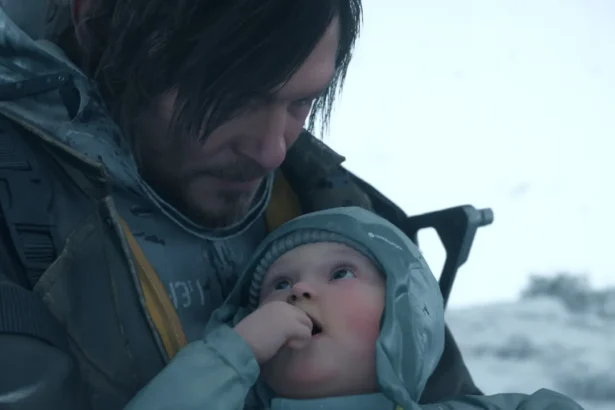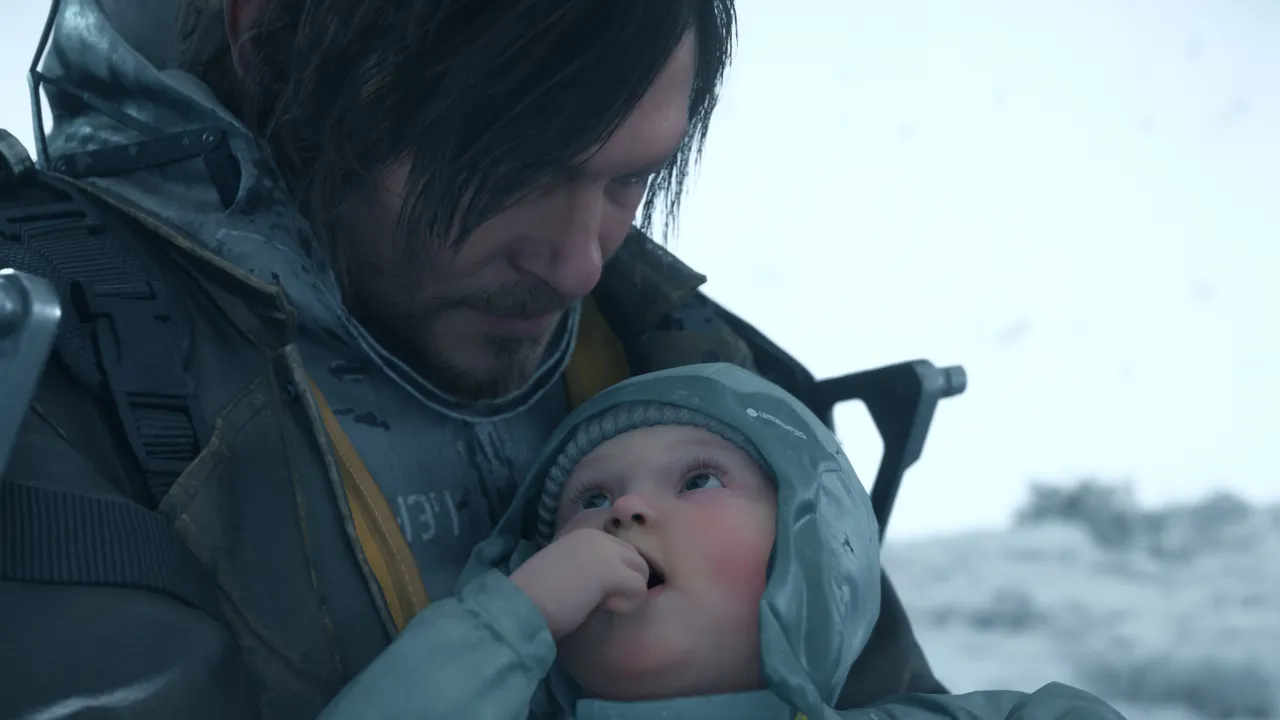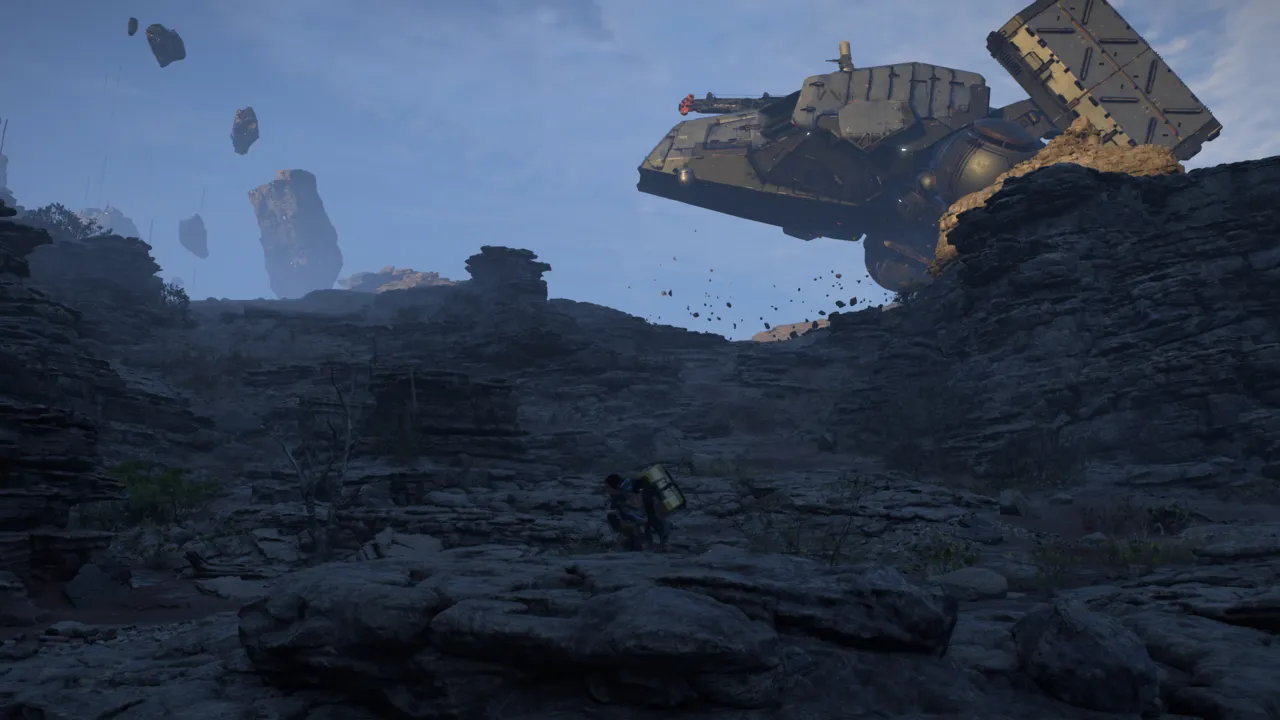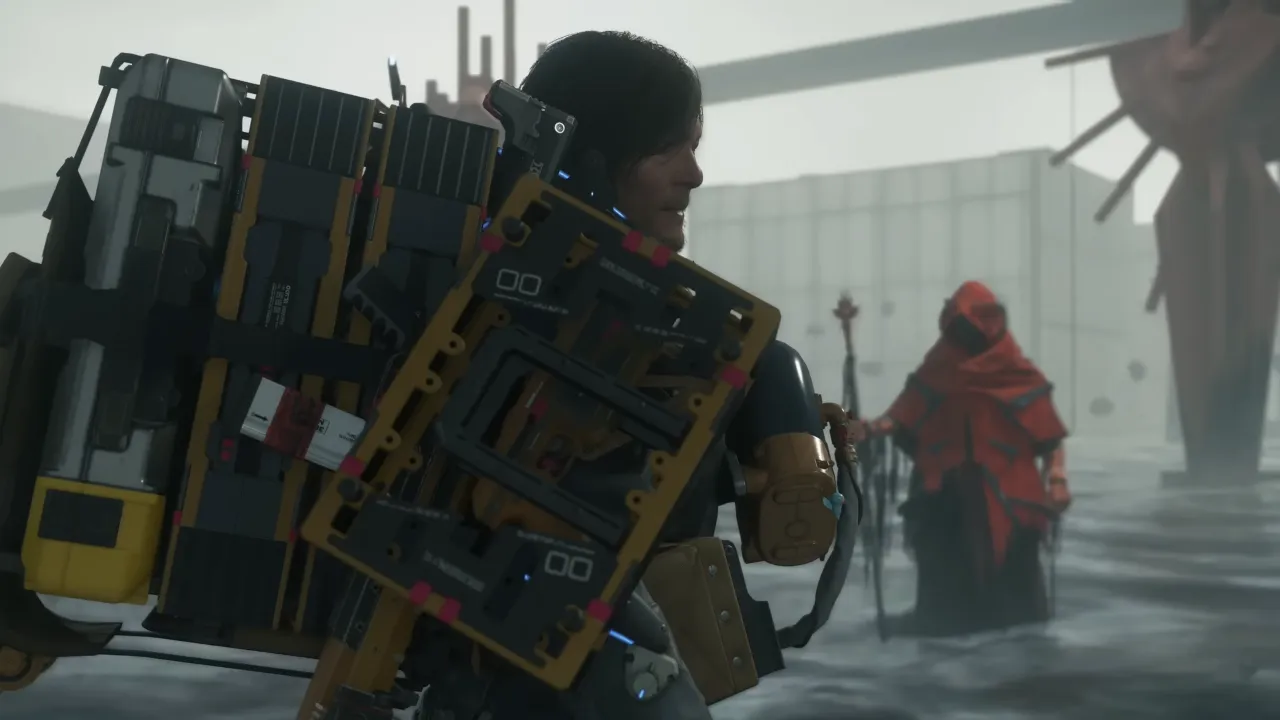I didn’t expect to cry while riding a coffin-shaped hoverboard across a sandstorm-battered plain, but that’s the sort of contradiction Death Stranding 2: On the Beach embraces with open arms. It’s the type of game where moments of absurdity, a talking crash test dummy on your belt, blood-powered boomerangs, and kangaroos locking eyes with you at dusk, somehow give way to the most sincere emotional resonance I’ve ever felt in a blockbuster. After forty-some hours running wild through a shattered Australia, dodging BTs, carrying emotional and literal baggage, and wondering whether connection is salvation or doom, I’m not sure I’ve come out the same person on the other end.
From the very beginning, Death Stranding 2 sets the tone by framing Sam Porter Bridges — once a disconnected deliveryman, now a reluctant father — not as a savior but a man clinging to quietness. The opening moments in Mexico, where Sam lovingly plays with Lou, the baby he once carried in a jar, are some of the gentlest in the game. Kojima lets these moments breathe before shattering them. That’s the rhythm: find serenity, lose it, struggle to reclaim it. And I found myself swept away by it every time.
There was a moment, just me and Lou, standing at the edge of a mountain where the sky was so blue giving hope. That silence before Fragile’s voice cracked through it was the last time I felt stillness in this world. And part of me knew it wouldn’t last.
When Fragile returns to pull Sam into one more job, this time to reconnect Mexico and Australia via a plate gate and the Chiral Network, rather than signing up for continent of deliveries, I found stepping back into a universe as beautiful as it’s terrifying, as ridiculous as it is profound. More than anything else, I realized Kojima is refining the wheel instead of simply reinventing, recontextualizing what made the original game so divisive and in my view, making it sing.
The game’s DNA is still that of a courier sim, but where the original often looked trudging uphill through mud for the sake of it, Death Stranding 2 smooths the friction. You’re given access to high-end tools far earlier this time, including customizable trucks, monorails, hoverboards, and exoskeletons. It could’ve easily turned the whole thing into an overpowered romp, but the good thing is in how these conveniences don’t erase the challenge but only lead to a shift. Environmental hazards like bushfires, sandstorms, and earthquakes still punish the careless, and I was strategizing with pins on my map, praying that my chosen river crossing wouldn’t sweep my cargo away.
And oh, the cargo. There’s something inherently great in organizing your loadout, managing Sam’s balance, plotting an optimal route, and executing the perfect delivery. Even after hours of gameplay, I’d feel that pang of anxiety when a box tumbled off my bike or an avalanche swept through. The fear of loss never goes away, and it reinforces the underlying theme that every connection, every success, is earned through careful thought and honest effort.
What surprised me most this time around, though, is how much more alive the world feels. Not in the sense of more NPCs or enemy density, but the way nature itself responds. Rain can turn a trickle of a stream into a rushing flood in minutes. Quakes turn the terrain under your feet. Flash floods, sandstorms, and other dynamic weather systems become obstacles you have to genuinely plan around. At one point, I perched on a cliff to wait for a dust storm to pass, squinting into the hazy distance, unsure if the shadow I saw was a BT or a dead tree. That’s how exciting and complex things are this time around.
While all this is happening, your emotional arc as Sam remains ever-present. His relationship with Lou is the beating heart of the story — understated, often silent, but always powerful. I couldn’t help but smile watching her giggle as Sam bounded down hills, or the way he quietly paused to tuck her in for a nap between missions. A game rarely lets a man be soft without undermining his strength, and Reedus delivers a performance that’s both stoic and painfully human.
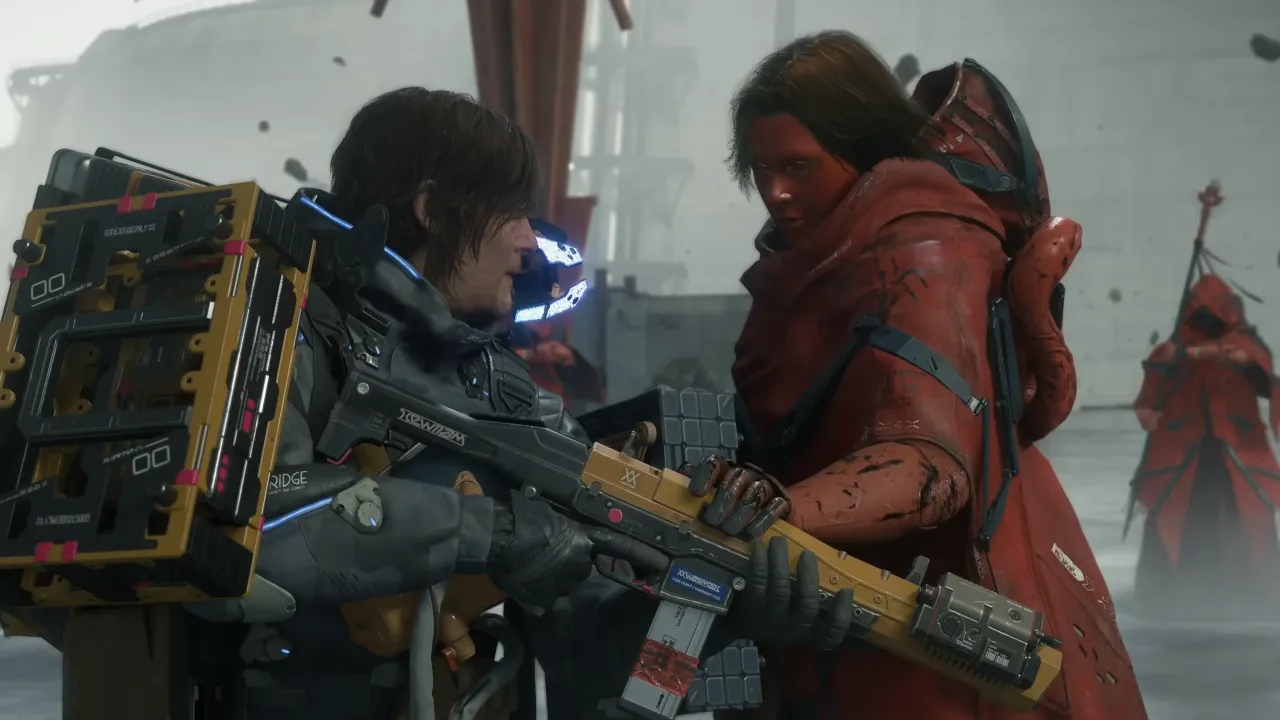
But the story doesn’t just ride on sentiment. Death Stranding 2 ramps up its stakes with the return of Higgs now a guitar-wielding, fire-breathing chaos agent, and a host of newcomers like Tomorrow, who can decay anything she touches, and Rainy, who can summon time-altering rain. I won’t pretend every character lands with the same weight. Some like Tarman and Dollman seem more like narrative devices than people. But others, especially Fragile and Tomorrow, bring genuine depth and ambiguity to the tale. Fragile’s story in particular, reimagining her as both leader and mother-figure aboard the Magellan ship, gave her far more agency than the first game afforded.
That said, the pacing isn’t perfect. The middle portion stretches a little too thin, with long stretches of deliveries peppered by only the lightest of narrative breadcrumbs. And while I appreciated the more involved combat encounters like stealth feels tighter, gunplay more responsive, and enemy variety broader, they sometimes detracted from the game’s meditative flow. I wasn’t thrilled when the game threw me into back-to-back firefights, mainly in a series that’s always leaned more on introspection than adrenaline. But to Kojima’s credit, even those moments are laced with meaning. The violence is never glamorized. When I unloaded a grenade launcher into an enemy convoy, I felt effective, but I also felt hollow. And that’s intentional.
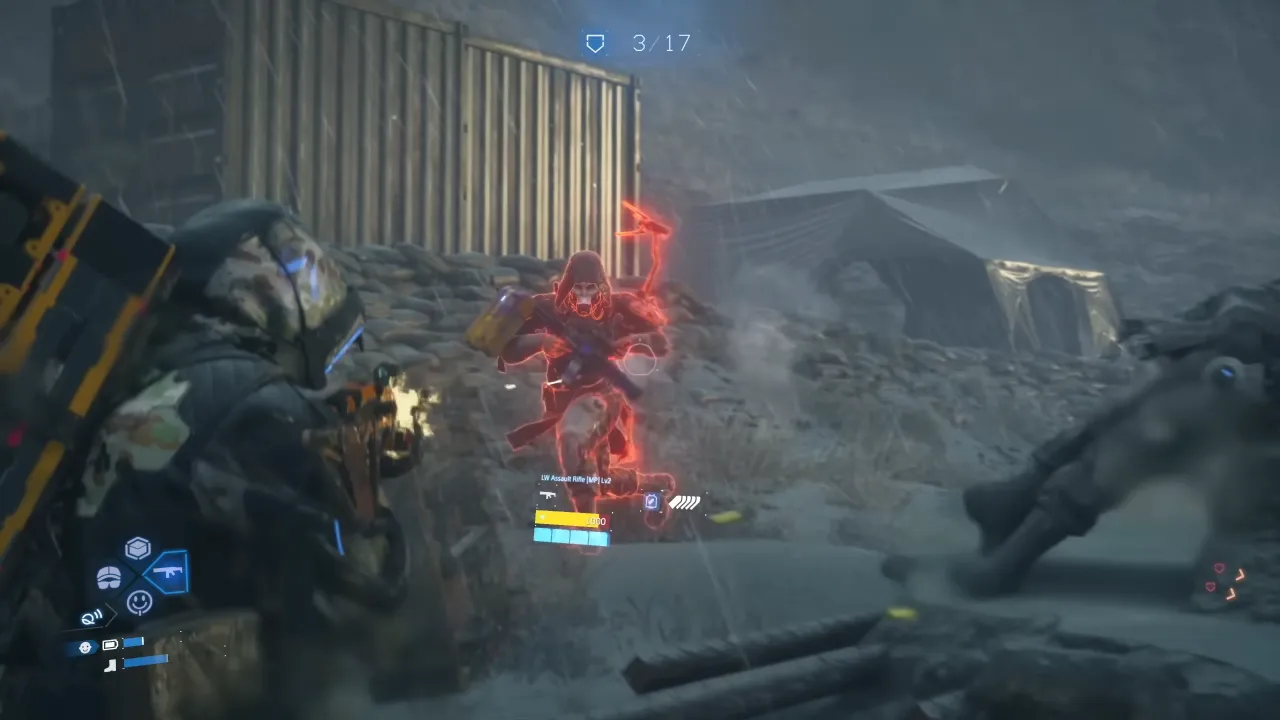
Death Stranding 2’s greatest strength might be its multiplayer, which is asynchronous and deeply human. The things other players leave behind — a ladder here, a generator there, a fully built monorail across the desert — aren’t simple tools. They’re proof that someone was here who cared enough to make your life a little easier. When a game is densely focused on isolation, these fleeting signs of human kindness land like gut punches. I lost count of how many times I gave likes to another player’s structure and thought, for a moment, like I wasn’t alone in this strange world.
What’s more, this sense of mutual support links directly to the game’s philosophical core. “Should we have connected?” It’s the question the game asks over and over, in both its dialogue and its systems. And the answer isn’t clean. There are moments when the Chiral Network feels like a miracle as it rebuilds civilization one delivery at a time. But there are others when it looks more a curse, a digital leash hiding under the guise of progress. The commentary on social media, gun culture, corporate control, and AI-driven identity is heavy-handed at times, but it’s hard to argue that it’s not relevant. In fact, it’s more pointed than ever.
You don’t remember the packages you dropped off. You remember the paths you carved, the cliffs you dared to descend, and the signs left by strangers who made the silence feel less alone.
Kojima has always been a maximalist, a man who can’t say in five words what he can say in fifty, and always with a slow-motion cutscene to boot. Death Stranding 2 is no different. It’s indulgent. Sometimes bloated. Often strange. There are long stretches of nothing followed by explosions of plot, delivered via soliloquies from characters with names like “Tomorrow” and “Dollman.” And yet, I found myself hanging on every absurd word.
The game’s third act, in particular, is peak Kojima: surreal, emotionally raw, and completely unhinged. It breaks the fourth wall. It rewrites the rules. It asks you to question everything you’ve been doing and while I won’t spoil what happens, I can say that it swings big. Some of such swings connect hard. Others seem like they’re trying a little too hard to impress. But all of them are unmistakably Kojima, for better and worse.
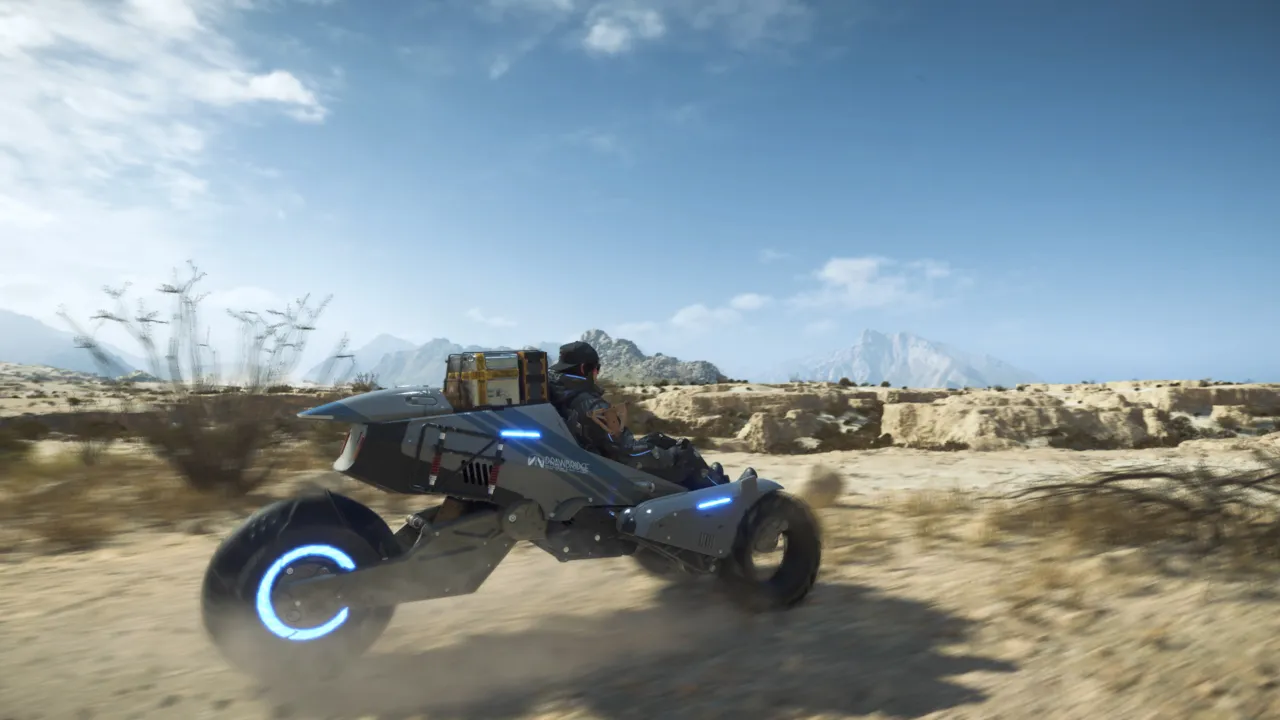
Technically, the game is fantastic. Running on the Decima engine, everything is great from the red dust of the outback to snow-draped mountain peaks and glistening, tar-slicked beaches. The soundtrack is masterful once again, with moments where Woodkid’s or Low Roar’s haunting vocals swell at the right time, making you stop and soak in the moment. And the performance capture is industry-leading. Characters like Fragile and Higgs don’t just move realistically — they emote in ways that make you forget you’re looking at polygons. The twitch of an eye, the way a tear slides down a cheek — it’s all there.
Still, Death Stranding 2 isn’t going to win over the skeptics. If you found the original too slow, self-indulgent, or weird, this sequel won’t change your mind. It’s weirder. Longer. Even more convinced of its own brilliance. But if, like me, you found something special in the quiet defiance of walking across a broken world with a heavy load and a heavier heart, this game is a reward. It’s a monument to creative vision unshackled from conventional rules and a deeply personal exploration of loss, hope, and the necessity and danger of human connection. Death Stranding 2 asks not just what we’re willing to carry, but who we’re carrying it for. And when the credits rolled after all the chaos, after all the melancholy and mayhem, I didn’t feel finished but felt fulfilled. Death Stranding 2: On the Beach is flawed, brilliant, excessive, and unforgettable. Just like Kojima himself. Just like the world it portrays.

